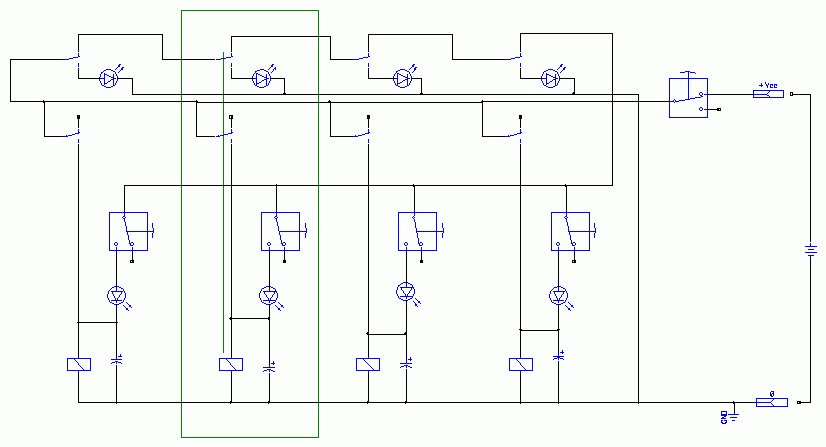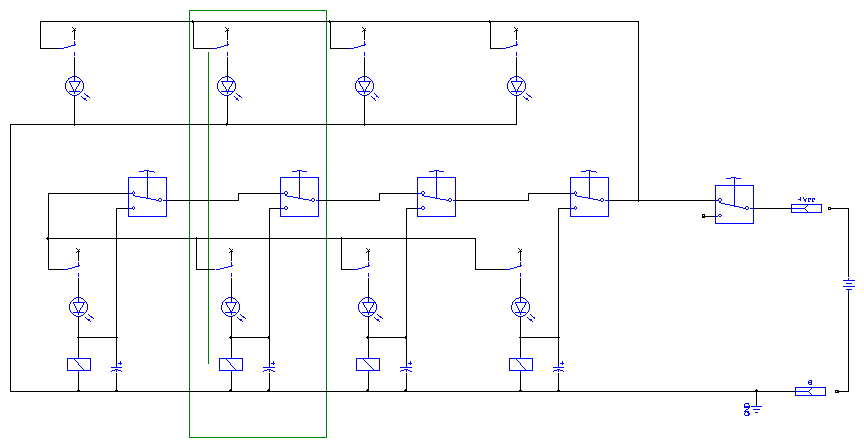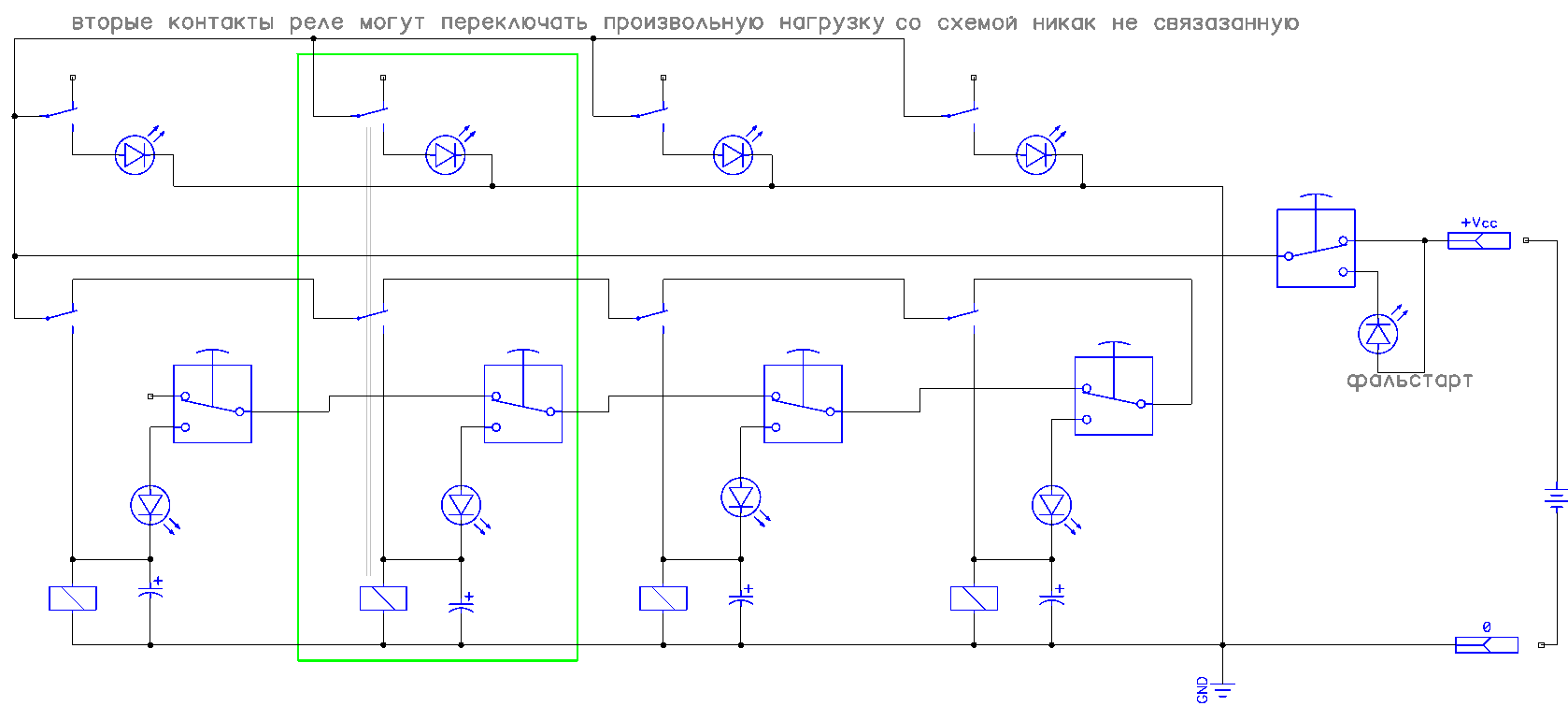Antiludism, why iron arduin
This is a response to the post habrahabr.ru/post/241407 "System for" His Game "" (in the comment he did not fit) - the scheme of turning on only one of several load channels with a block of the rest with a single click on the corresponding channel button.
Here is my version of the same, but without a computer with Windows, arduins, and even without a microcontroller. And without any chips at all. And even without transistors. The number of channels is unlimited. 5 simple cheap parts per channel.

(He drew a scheme here longer than he soldered)
For each channel: 1pc relay. + button + two [light] diode. And + capacitor, if the game is responsible - everything works without them, but sometimes it is not clear. The buttons are not fixed "clock".
One channel is highlighted by a green rectangle, while the contacts of one relay in this channel are triggered - indicated by a green line between the coil and the contacts.
')
Channels (players) - as much as you like, consumption when waiting - ZERO, at the entrance there is a “reset” button, it is “on” if it is a toggle switch. It is logical to finish it with a “false start” in a bunch of ways.
The supply voltage and the parts are selected to each other - I have “in the gland” as an option with 12-volt TTI relays, and with 3.3-volt polar axicom (they have a built-in diode immediately - the inductance disconnect current rings).
Description of work:
In standby mode, all relays are turned off, the diodes are off, the buttons are open, there is no current consumption. When you click on one of the buttons - the corresponding relay is turned on, which turns on itself to power directly, disconnecting its second contact from the power of all the others. Including the "own" button - this is what the Conder is for - if the inductive and mechanical inertia of the solenoid and the yoke with the contacts is not enough to connect the bottom contact on the circuit after the top one turns off. Usually enough, but the relay can be all sorts - so if there is no sustained switching on - then add a capacitor, with RC = ~ half a second plus or minus bast, (Relay and its response time watch datasheet). I stuck randomly at 50 microns for 3p / pc, thanks to their long legs dispensed without wires when mounted. The price of the question turned out to be about one hundred rubles per channel ± 146%, depending on the pretentiousness of the buttons and prices in local e-boutiques.
Soldered all right on the legs of the relay, I will not show the photo, because it looks terribly indecent.
The upper LEDs conventionally show the payload of the main function of the whole circuit, but, like the lower ones, it is diodes that are needed to make it impossible to reverse the current through the pressed button of one player on the relay of the other, if both are pressed almost simultaneously. The “simultaneity window” is approximately equal to the response time of the relay — to watch datasheets or measure them in fact, for I fed for example. 12-volt relays with 3 finger-type batteries and they switched significantly longer than from their 12-volt batteries. When simultaneously pressing the priority is obtained from the one on the left of the diagram, the simultaneous inclusion of two channels is impossible.
The main drawback of the circuit is a large number of connecting wires, if the button posts / consoles are spaced apart, and - the failure of any leads to the inoperability of everything.
Initially about the same:

The scheme was made for the selector of audio inputs (or outputs) of some demo stand instead of the furiously controller horror issued “to the mountain” by a young electronic engineer (either he messed up or not paid and the bookmark worked out, but the circuit could not work without glitches and a pair of clocks and, moreover, gave a hindrance in the line). In it, the algorithm is the opposite: “sneakers are the last” - each button connected the corresponding channel, disconnecting all the others, and it remained connected while there was power and did not press the other button.
And I also have about the same "scheme" right away on the power actuators and their buttons - it switches the heating zones in some kind of production. Alas, there are no beautiful pictures - just an electric box with starters, wires, buttons.
I suspect that in the pre-electronic era the lifts worked in this way and, looking at how the service men in my house suffer with the new smart Shcherbinsky elevator, I strongly regret the forced, in view of the 30th anniversary, the replacement of our healthy old.
This is not an “article”, but only a small illustration of the capabilities of simple circuits on simple details — to implement it, neither a computer, nor PCB, nor an iron, nor a development environment — just a pencil-paper, a handful of parts, and a soldering iron are needed. Well, a couple of hours in the transport to invent. It is written after I saw that electronics students look at this as a smart switch - “I see buttons, I see output relays, and where is the board with logic?”. And although I consider microcontrollers themselves for humanity a step comparable to motors-engines, sometimes I still want to exclaim: “Gentlemen, do not over-complicate the world in vain!”
- upd:
I added a more symmetrical and more visual variant from the commentary here:

- upd2:
and also simplified - here the game is that the relay typically has a holding current less than the switching current:

Here is my version of the same, but without a computer with Windows, arduins, and even without a microcontroller. And without any chips at all. And even without transistors. The number of channels is unlimited. 5 simple cheap parts per channel.

(He drew a scheme here longer than he soldered)
For each channel: 1pc relay. + button + two [light] diode. And + capacitor, if the game is responsible - everything works without them, but sometimes it is not clear. The buttons are not fixed "clock".
One channel is highlighted by a green rectangle, while the contacts of one relay in this channel are triggered - indicated by a green line between the coil and the contacts.
')
Channels (players) - as much as you like, consumption when waiting - ZERO, at the entrance there is a “reset” button, it is “on” if it is a toggle switch. It is logical to finish it with a “false start” in a bunch of ways.
The supply voltage and the parts are selected to each other - I have “in the gland” as an option with 12-volt TTI relays, and with 3.3-volt polar axicom (they have a built-in diode immediately - the inductance disconnect current rings).
Description of work:
In standby mode, all relays are turned off, the diodes are off, the buttons are open, there is no current consumption. When you click on one of the buttons - the corresponding relay is turned on, which turns on itself to power directly, disconnecting its second contact from the power of all the others. Including the "own" button - this is what the Conder is for - if the inductive and mechanical inertia of the solenoid and the yoke with the contacts is not enough to connect the bottom contact on the circuit after the top one turns off. Usually enough, but the relay can be all sorts - so if there is no sustained switching on - then add a capacitor, with RC = ~ half a second plus or minus bast, (Relay and its response time watch datasheet). I stuck randomly at 50 microns for 3p / pc, thanks to their long legs dispensed without wires when mounted. The price of the question turned out to be about one hundred rubles per channel ± 146%, depending on the pretentiousness of the buttons and prices in local e-boutiques.
Soldered all right on the legs of the relay, I will not show the photo, because it looks terribly indecent.
The upper LEDs conventionally show the payload of the main function of the whole circuit, but, like the lower ones, it is diodes that are needed to make it impossible to reverse the current through the pressed button of one player on the relay of the other, if both are pressed almost simultaneously. The “simultaneity window” is approximately equal to the response time of the relay — to watch datasheets or measure them in fact, for I fed for example. 12-volt relays with 3 finger-type batteries and they switched significantly longer than from their 12-volt batteries. When simultaneously pressing the priority is obtained from the one on the left of the diagram, the simultaneous inclusion of two channels is impossible.
The main drawback of the circuit is a large number of connecting wires, if the button posts / consoles are spaced apart, and - the failure of any leads to the inoperability of everything.
Initially about the same:

The scheme was made for the selector of audio inputs (or outputs) of some demo stand instead of the furiously controller horror issued “to the mountain” by a young electronic engineer (either he messed up or not paid and the bookmark worked out, but the circuit could not work without glitches and a pair of clocks and, moreover, gave a hindrance in the line). In it, the algorithm is the opposite: “sneakers are the last” - each button connected the corresponding channel, disconnecting all the others, and it remained connected while there was power and did not press the other button.
And I also have about the same "scheme" right away on the power actuators and their buttons - it switches the heating zones in some kind of production. Alas, there are no beautiful pictures - just an electric box with starters, wires, buttons.
I suspect that in the pre-electronic era the lifts worked in this way and, looking at how the service men in my house suffer with the new smart Shcherbinsky elevator, I strongly regret the forced, in view of the 30th anniversary, the replacement of our healthy old.
This is not an “article”, but only a small illustration of the capabilities of simple circuits on simple details — to implement it, neither a computer, nor PCB, nor an iron, nor a development environment — just a pencil-paper, a handful of parts, and a soldering iron are needed. Well, a couple of hours in the transport to invent. It is written after I saw that electronics students look at this as a smart switch - “I see buttons, I see output relays, and where is the board with logic?”. And although I consider microcontrollers themselves for humanity a step comparable to motors-engines, sometimes I still want to exclaim: “Gentlemen, do not over-complicate the world in vain!”
- upd:
I added a more symmetrical and more visual variant from the commentary here:

- upd2:
and also simplified - here the game is that the relay typically has a holding current less than the switching current:

Source: https://habr.com/ru/post/371613/
All Articles